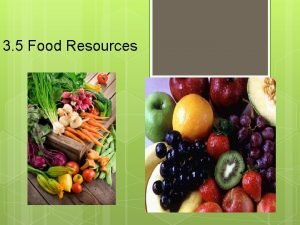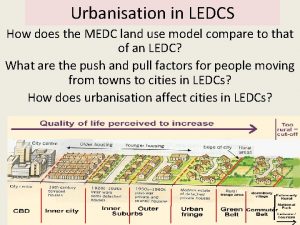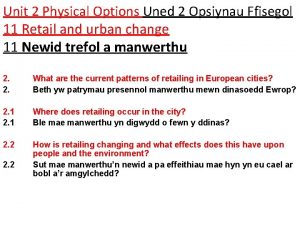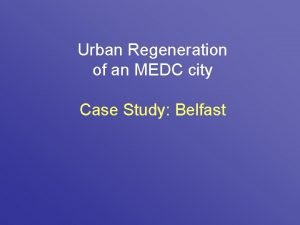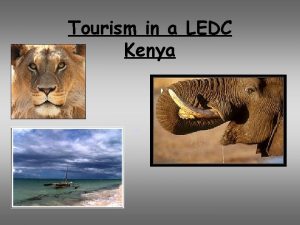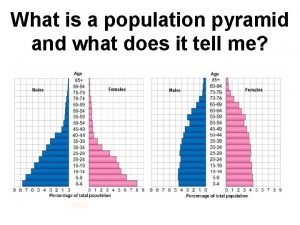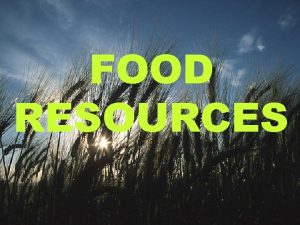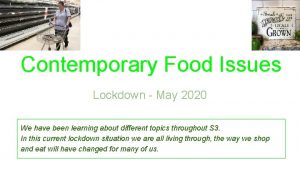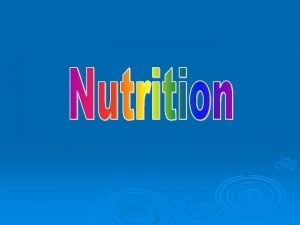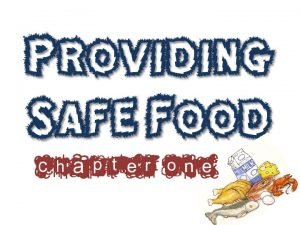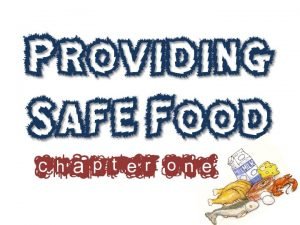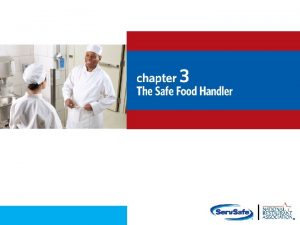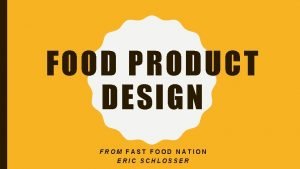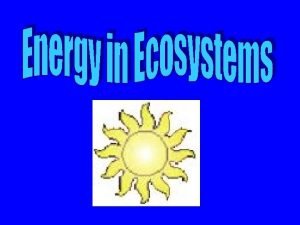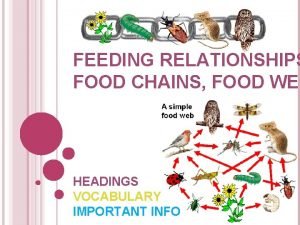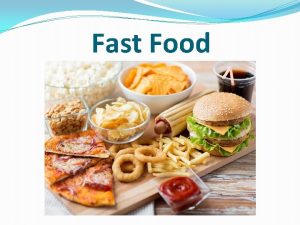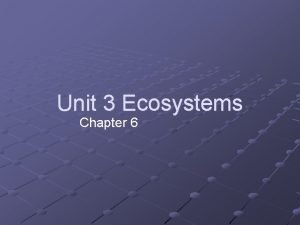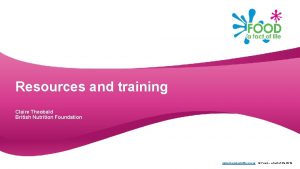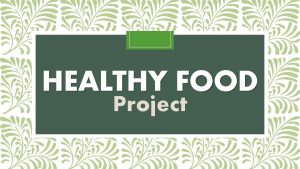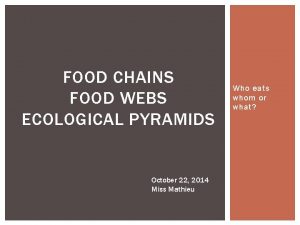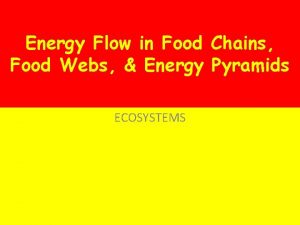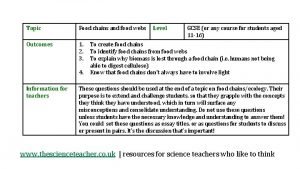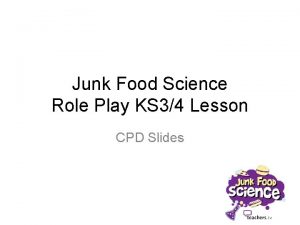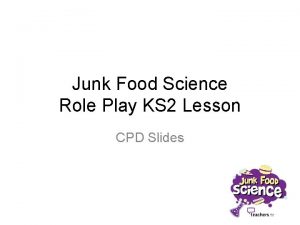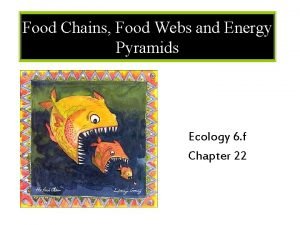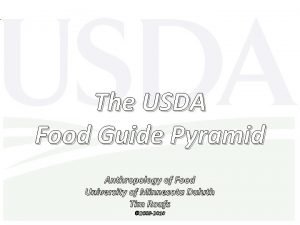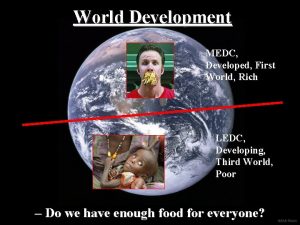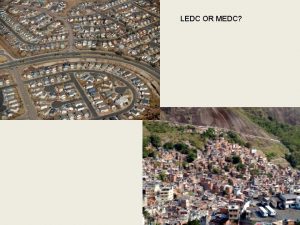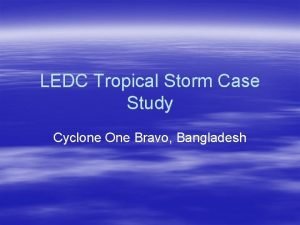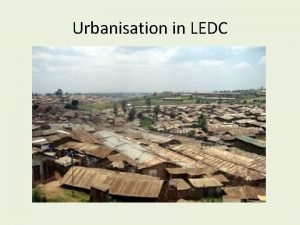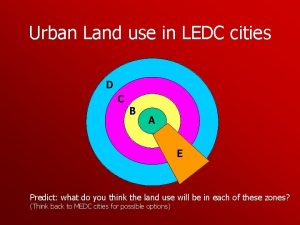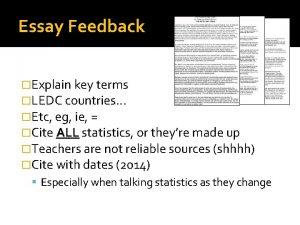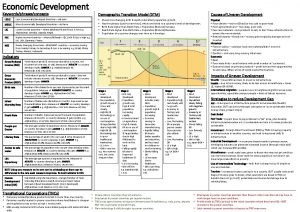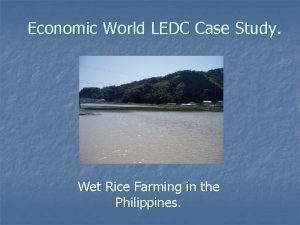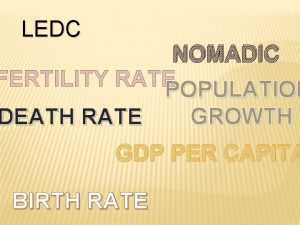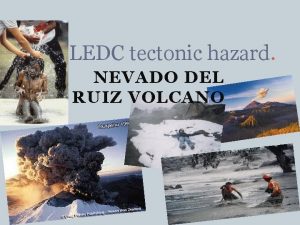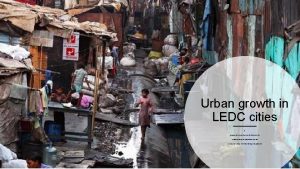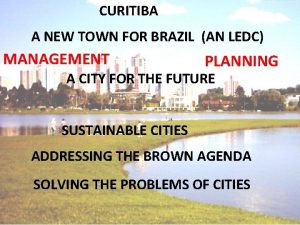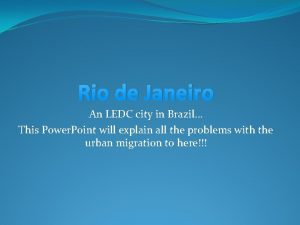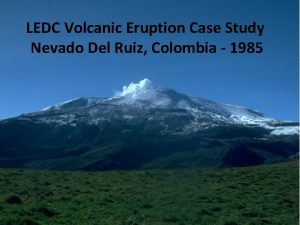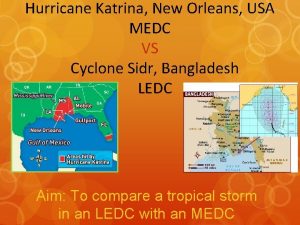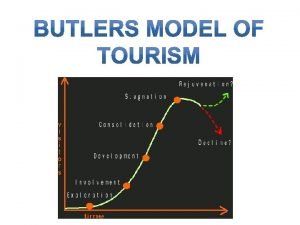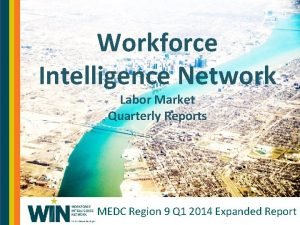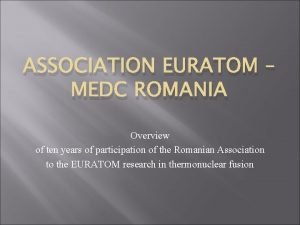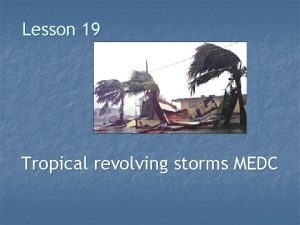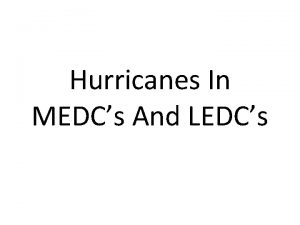3 5 Food Resources Food Issues MEDC LEDC







































- Slides: 39

3. 5 Food Resources

Food Issues MEDC / LEDC

Food Production and Distribution

Imbalance in food distribution Over 1 billion people are living in poverty and starving in LEDC countries MEDC Average Caloric Intake = 3314 LEDC Average Caloric Intake = 2666 Causes: Unequal distribution Lack of access to clean water Poor harvesting / farming practices (overgrazing/ overfishing)

Undernourishment worldwide

Food Waste

Terrestrial vs. Aquatic Food Production Systems VS

Aquatic Food Production Aquatic Food Production: Food is harvested from high tropic levels due to human preference (ex. salmon). Photosynthesis is less efficient by producers due to light reflection of water

Terrestrial Food Production Terrestrial Food Production: Most food harvested from low tropic levels (producers / herbivores) Energy conversions less efficient on land

Food Production affects the Environment Biodiversity Soil Water Air Human Health

Increasing food production output GMO- Genetically Modified Organisms Change genetic make up of living things to make them look, feel, and taste different Pesticides- chemicals used to kill pest organisms Herbicides- chemicals used to kill weeds Fertilizers- chemicals used to grow larger crops Irrigation- canals used to bring in more water Antibiotics/ Growth Hormones- used to grow healthier and larger animals

Biodiversity Loss of grasslands forests and wetland for cultivation Loss of genetic diversity (wild crops replaced with monocrops)

Soil Erosion Loss of fertility Salinization Desertification Increase soil p. H

Water Waste water produced Aquifer depletion from increased irrigation

Air Large fossil fuel use in farming equipment causes release of greenhouse gases (CO 2, N 2 O, and CH 4) Pesticide sprays

Human Health Nitrates in Drinking water Blue baby Pesticides Bacterial contamination of meat (E. coli)

North American Cereal Farming vs. Asian Subsistence Farming

Comparison Pair #1 North American Cereal Farming Inputs: Fertilizers, pesticides, fossil fuels, labor, sunlight, water equipment Characteristics: Heavy use of fossil fuels, lots of farming technology, monocrops (only one crop) Socio- Cultural: Fast production, large amounts, lots of waste Environmental impact: loss biodiversity Outputs: Air pollution , water pollution, wheat/corn, lots of income ($$) Asian Subsistence Farming Inputs: lots of human labor, water, sunlight Characteristics: grow only enough to eat to feed family & community, low tech Socio- Cultural: mostly LEDC, poor Environmental impact: maintains biodiversity, reduces pollution Outputs: Usually mixed crops; corn, beans and squash (all in same field)

Intensive Beef Production vs. Maasia Tribal Livestock

Comparison Pair # 2 MEDC- Intensive Beef Production Inputs: Hormones, antibiotics, labor, cattle feed (corn), breeding stock of cattle Characteristics: Many cattle in crowded area Socio- Cultural: Fast production, large quantities, lots of waste/death Environmental impact: disease, waste Outputs: Air pollution, water pollution, beef, lots of income ($$) LEDC- Maasai Tribal Livestock Inputs: Labor, Cattle feed/ grazing grass Characteristics: large herds of cattle, used as only food source “Nomadic Herding” Socio- Cultural: Cattle are THE source of life (even used as currency) Environmental impact: overgrazing, nomadic behavior Outputs: meat, milk, blood

Salmon Farming in Norway vs. Rice. Fish Farming in Thailand

Comparison Pair # 3 Salmon Farming in Norway Inputs: antibiotics, fish food, cages, labor Characteristics: fish raised in large quantity Socio- Cultural: MEDC, employs large number of workers Environmental impact: growth of algae, water pollution Outputs: salmon, water pollution Rice-Fish Farming Thailand Inputs: labor, seed Characteristics: fish and rice grown together in same, self sustaining ecosystem (fed by natural food chain) Socio- Cultural: LEDC countries, Environmental impact: reduces waste maintains biodiversity Outputs: rice, fish, income

Slash and Burn/ Shifting Cultivation

Slash and Burn / Shifting Cultivation Input: Labor, plow, oxen, seed Characteristics: Tropical forest set on fire to clear the land & ash fertilizes soil. After land is used farmers repeat this process Socio-cultural: Typically harvested food is sold in community, low population density Environment: Loss of biodiversity, fertility, ecosystem production decreases Output: Monocrop, air pollution, income

kg grain required to produce 1 kg of meat

GMO


Become more sustainable

Food Distribution Worldwide Welcome to the hunger banquet Please take a number

Poverty in the world 16% of Children are undernourished 400 million have no access to clean water 14 % have no access to heath care

Food Production/Distribution Plan a banquet for the class? Main Dish Snack foods Beverages Forks Paper Plates Cups Desserts

Poverty in the world

Poverty in the world 1. 2 Billion people live on less than $1 a day!! 2. 8 Billion people live on less than $2 a day 3, 900 children die daily from lack of safe drinking water and adequate sanitation. (1. 4 million children a year!) 10 million children die each year before reaching their 5 th birthday.

Roles of the world #1 = 15% (3 -4 people), High Income– #1 High Income Unlimited access to all foods (as much as you want!) Have a Seat at the table with the table cloth and plates Per capita income: $9, 386 or more

#2 Middle Income #2 = 30%(~8 people), Middle Income– Mostly access to grains, fruit and vegetables, few meat products (nothing packaged) Fill only ½ of your plate Have a Seat at the table with paper plates Per capita income: $766 - $9, 385

#3 Low Income #3 = 55% (~15 people), Lower Income, You may only eat Plain Rice and Water (fill no more than ¼ of your plate!) Have a seat on the floor Per capita income: $765 or less.

How does food production impact others in the world? Food production in our country has a direct impact on the lifestyle and income of others around the world http: //vimeo. com/8812686

Make a list of 3 meals (breakfast, lunch and dinner) that can Final Assignment be purchased, made or consumed for under $1 in total. List total calories of this meal List nutrients content of the meal % Carbohydrates % Fat % Protein Find one country that lives on less than $2 each day, and research their typical diet and infant mortality rates.

Discussion Questions Do you think the high income are obligated to help the poor? Do you think it’s fair that the world is divided up into these classifications? Do you think people are poor because they don’t work hard and are lazy? What can be done to ensure resources are distributed more fairly?
 Medc ledc
Medc ledc Medc
Medc Medc
Medc Medc city
Medc city Aims and objectives of tourism
Aims and objectives of tourism Is bangladesh an ledc
Is bangladesh an ledc Population pyramids
Population pyramids Food resources world food problems
Food resources world food problems Transformation process
Transformation process Fixed and variable resources
Fixed and variable resources Renewable resources vs nonrenewable resources
Renewable resources vs nonrenewable resources Unit 2 food food food
Unit 2 food food food Grazing food chain diagram
Grazing food chain diagram Contemporary food issues
Contemporary food issues Food scientist measure food energy in
Food scientist measure food energy in What is a tcs food
What is a tcs food Which food is a tcs food
Which food is a tcs food A little food or a few food
A little food or a few food Food web
Food web Food handlers can contaminate food when they:
Food handlers can contaminate food when they: Food product design from fast food nation by eric schlosser
Food product design from fast food nation by eric schlosser Terrestrial food chain example
Terrestrial food chain example Producers in a food web
Producers in a food web Food chain
Food chain Fast food can be defined as any food that contributes
Fast food can be defined as any food that contributes Easy food web
Easy food web A consumer that primarily eats one specific organism
A consumer that primarily eats one specific organism Food chain
Food chain Bnf explore food
Bnf explore food Junk food vs healthy food project
Junk food vs healthy food project Food chains, food webs and ecological pyramids
Food chains, food webs and ecological pyramids Food chain and food web examples
Food chain and food web examples Food webs and energy pyramids worksheet answers
Food webs and energy pyramids worksheet answers Dessert food chain
Dessert food chain How many food chains are there in the food web
How many food chains are there in the food web Role play on healthy food and junk food
Role play on healthy food and junk food Of junk food
Of junk food Healthy food vs junk
Healthy food vs junk Food web of the desert
Food web of the desert 1992 food guide pyramid
1992 food guide pyramid
